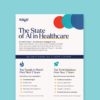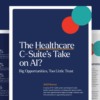Six months ago I reflected on my time at JPM2024 with a piece titled “Hope, but not confidence.”
At the time, I imagined that if Paul Revere were an investment banker attending this year’s conference, he would be running ahead of us all, proclaiming: “The books are coming! The books are coming!” While the other investors would think he was crying wolf, the companies, founders, and boards would feel hopeful—but not exactly confident. Hopeful that their end markets were finally ready again to pony up with vigor.
So, should we heed his cry? Let’s take a quick look back: The first six months of 2024 netted $5.7 billion of investment across 266 deals. If this trend continues, that puts us above 2019 and on par with or slightly better than 2023. A return to “normalcy”—or, at least, a sober benchmark. And some of what boomed during the wild times, may have a much longer road—physician practice management platforms may well be among the hardest to reconcile, especially those in segments that have been scaled.
But following two years of wild (and often dumb) investing in between ‘19 and ‘22, there is still plenty of scorched earth working its way through the market. In the absence of company coffers being falsely inflated by investment dollars, we have seen the market do what it does, and should do: let companies die, reward businesses that have achieved product-market (not merely investment) fit, prioritize value over valuation, invest in marketing to earn customer trust through thought leadership rather than press releases and funding rounds, focus on profit and unit economics (mind blowing, of course)—and the list goes on.
At Sage, our mandate is to help healthcare companies grow. We support our client partners through a dynamic mix of industry-specific growth strategy and growth marketing. That means we are not immune to the industry’s pain; we too are deeply connected and impacted by these market trends. We have been tracking all of these forces on the ground with our clients, their investors, and a closely held and trusted group of friends (investors, investment bankers, and search firms).
Commercial investments still In the desert: Cash droughts have impacted commercial investments. If companies do invest in go-to-market or marketing, the decision requires many approvals, the investment is small—but the hopes of impact are high.
Strategy and market intel, meh : This intel may be welcomed, but investing here is often viewed as a science project with a barometer that reads: “sales is the only thing that matters.” So, strategy may actually be a dirty word for many.
Know thyself: Identity, Brand, and Product Market fit reign supreme. While this ideal is defined, the pathway there remains hazy. The struggle for a refined, clear identity is still very real.
English is a second language: Investors and management teams still “over-rotate” and indulge in multi-syllabic, industry jargon, with outsized promises in their messaging and story—hoping to give themselves “optionality.” Buyers (who don’t even understand these fancy B-school words) can’t understand it, and, even worse, don’t believe it. Using common words with uncommon impact is hard—but incredibly powerful.
M&A: Numbers three and four are complicated by the uptick in M&A—these challenges are typically exacerbated as companies combine and experience both internal and external identity crises.
Brand love: Founders tend to love their brands, even if they have no idea who knows them, or, who even cares. Brilliant brands take time to build, and they are way more than a logo or a name. Brand pride should give way to practicality and sobriety about the important long game of brand building. While the industry accepts long sales cycles, we can’t seem to accept the notion of a marketing cycle—but we should. Marketing, especially good marketing, takes time and should be left to the professionals.
Health economics matter: It is important to frame how an offering impacts and improves key drivers like Total Cost of Care, FFS growth, shifts of revenue and costs by site of care, etc etc. Trust us—no one has all the data. But selling without the math is myopic.
Adopt a “revenue first” mindset: We think the road to recovery is measured in years, not quarters. No ‘flip the switch’ moment will save the market. We enjoyed massive cash influxes for years with low to no inflation and almost free money. That game is over. Growth will be best measured in revenue first, rather than empty valuation. Take care of revenue and multiples will follow. Capital fuels growth—it does not equal growth.
Do good and make dough: There is still a massive opportunity to improve healthcare and make money. Consider this: we spent $1.4 trillion last year just on Part A, hospital spending. Our total healthcare spend was $1.4 trillion in 2023—whoa!. Consider that Part A, at $1.4 trillion, is more than 2x Walmart’s revenue (just the biggest global business). The problem is huge—and you can do very well even in small corners, even without ginormous TAMs.
We’re seeing some ink: The market is beginning to thaw. We are starting to see companies doing less window shopping and starting to make more—albeit modest—investments in growth.
2025 growth starts now: Let’s get going. The time for contemplation has passed. H2 can’t be more of this hold-hold-hold mindset if companies expect growth next year.
All that glitters AIn’t gold: The next gold rush, tomfoolery, outsized dreams of unicorn status, and race to deploy capital is happening in real time with AI. We are defiantly (or definitely) excited and bullish about the need and power of AI. But with AI, we all have a lot to learn. As we learn more about AI, we see a lot of potential quackery—there are true AI experts, and they have been working on solutions for years, not weeks. Few have been truly focused on healthcare. Let’s not fool ourselves that you can just slap an LLM together, package a piece of automation, mention AI, and therefore, you have arrived. If data is the new oil, the “slap it together” approach I just mentioned is OLIVEoil—investors beware!





